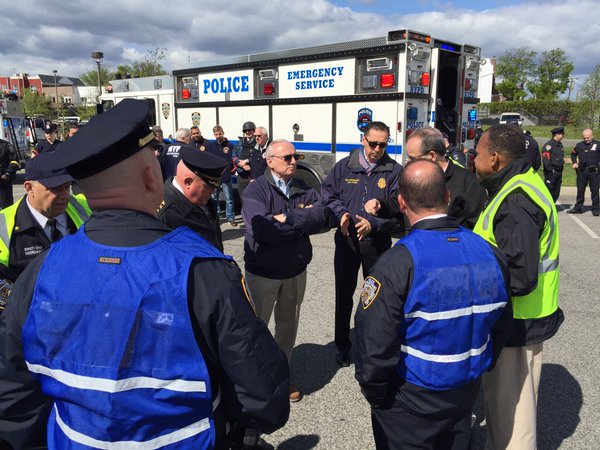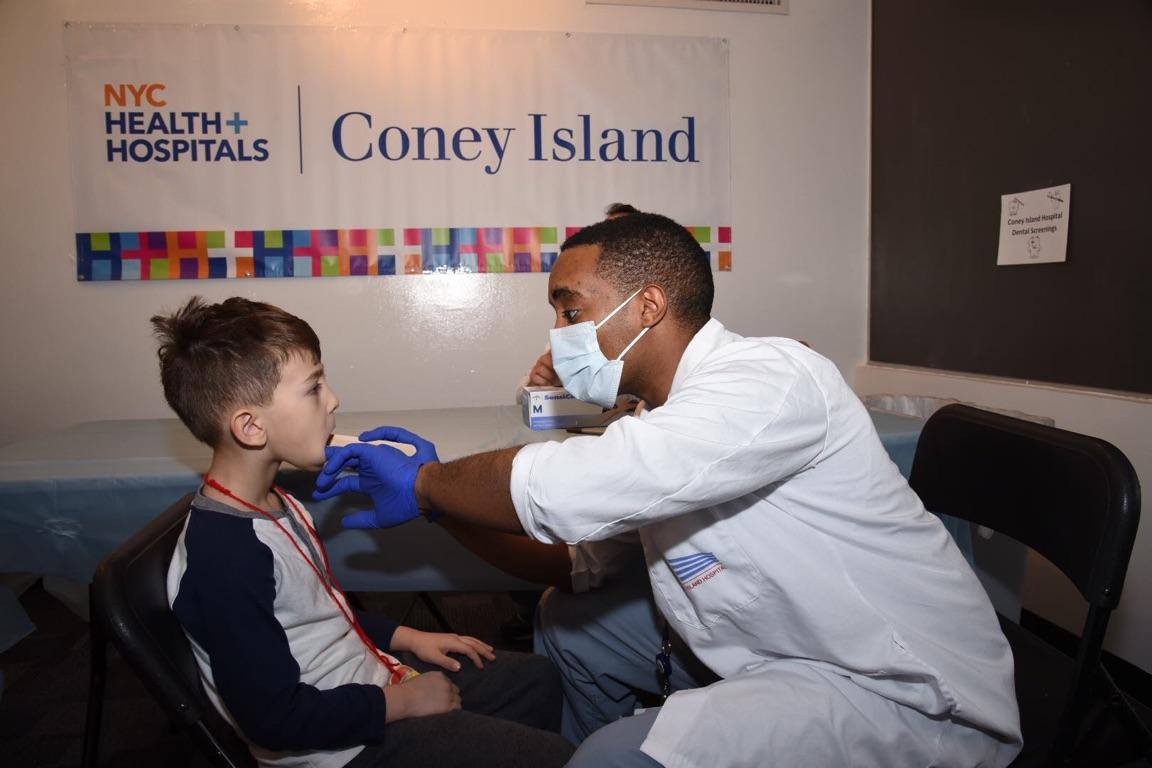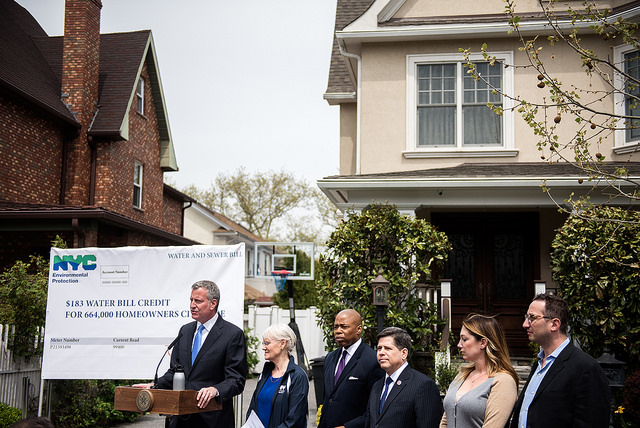NYPD 'Peace Dividend' Reveals Truth About Unnecessary Arrests

Commissioner Bratton and others (photo via @NYPDnews)
Last May, NYPD Commissioner Bill Bratton issued a 41-page report extolling the virtues of Broken Windows and quality-of-life policing, and promoted what he termed a “peace dividend” of “nearly a million fewer enforcement contacts like arrests, summonses, and reasonable-suspicion stops when compared to their respective highs.” He explained further in a letter to City Council Speaker Mark-Viverito: “there has been a drastic reduction in enforcement contacts between police and citizens, a benefit of lower crime that I call the Peace Dividend.” He clarified that the “dividend” is the “diminished need to use enforcement tools for every problem."
The use of the phrase “peace dividend” is telling and alarming. The term was frequently used at the end of the Cold War when many nations cut their military spending and money originally intended for the military became available for other purposes. No doubt while the Commissioner was fighting his war on crime, the police felt like an occupying army to black and Hispanic people living in neighborhoods that bore the brunt of a policy of massive arrests for trivial things.
While the commissioner’s notion of a dividend does not seem to correspond to additional government funds allotted to badly needed social programs in the affected communities, it does at least mean that more people in those same communities might be left in peace. On the other hand, Bratton’s pronouncement is redolent of an omnipotent overlord magnanimously bestowing a gift upon the residents of neighborhoods like South Jamaica, Brownsville, Mott Haven, and East Harlem, where rampant arrests and summonses have created immeasurable alienation, damage, and suffering.
Recently, in the course of another round-up of crime statistics, Commissioner Bratton noted that arrests were down by about 10 percent in April. In an effort to explain the drop, he said that the police were making fewer arrests for minor offenses and that “[w]e are trying to reduce the number of contacts we have with the public that [are] not necessary.”
On its face, continued evidence of the so-called peace dividend is laudable. Decreasing unnecessary police-citizen interactions is obviously a worthy goal. But upon closer inspection, the commissioner’s explanation is troubling and revealing.
Shouldn’t he try to eliminate, rather than reduce, unnecessary police-citizen contact? While the commissioner’s acknowledgement that some number of police-citizen contacts is unnecessary is notable for its candor, it is also disturbing for its veracity – it begs the questions of just how many unwarranted interactions there are and upon whom are they inflicted. Answering these questions is not easy, but is essential.
Former Mayor Michael Bloomberg and his police commissioner, Ray Kelly, repeatedly and defiantly argued that the ever-rising number of stops-and-frisks – that peaked at almost 700,000 in one year (2011) – were necessary for public safety. When a federal judge ruled that the stops were unconstitutional, Bloomberg excoriated the judge saying, "[T]his is a very dangerous decision made by a judge who I believe does not understand what good policing is."
To drive his point home, he observed that he was glad that the implementation would likely take place after the end of his term, saying, "I wouldn’t want to be responsible for a lot of people dying." Well, crime continues to decline even as the number of recorded stop-and-frisks has plummeted to a current estimate of 25,000-35,000 for 2016 (a drop of around 95 percent from the high), providing powerful evidence that hundreds of thousands of stops were unnecessary, as well as illegal.
In similar fashion, the 10 percent reduction in misdemeanor arrests has not corresponded to an uptick in crime, suggesting that perhaps the ‘peace dividend’ is being miserly applied. Why not 15 or even 25 percent? Why not try a pilot program in some precincts to see how far the dividend could go? The NYPD issues about 1,000 summonses each year for riding a bike on the sidewalk in East New York. What if the officers in that precinct were instructed not to issue any summonses for unlawful bike-riding for some period of time? If crime did not correspondingly increase, the same approach could be taken with similar low-level offenses in that and other precincts, and the number of unnecessary police contacts with the public could be further reduced.
The awareness of necessary versus unnecessary contacts even runs through the NYPD rank and file. Back in December 2014 and into early 2015, police officers engaged in a slowdown to express unhappiness with Mayor de Blasio’s handling of Eric Garner’s death at the hands of Police Officer Daniel Pantaleo and the killings of Police Officers Wenjian Liu and Rafael Ramos. An email, widely believed to be from the Patrolmen’s Benevolent Association, was circulated instructing officers to make arrests only when it was “absolutely necessary.” Arrest numbers dropped precipitously over the next few weeks leading to the recognition that the NYPD’s standard operating procedure included an awful lot of unnecessary arrests. Consider as well that the crime rate continued to drop even in the face of drastically reduced arrests, tickets and stops.
Hyper-aggressive policing tactics like stop-and-frisk and Broken Windows enforcement drove the number of unnecessary police contacts with the public into the millions. More specifically, it did indeed amount to a war waged in and upon communities of color. Commissioner Bratton’s peace dividend has a long way to go to rectify that reality.
***
Steven Zeidman is a professor of law at CUNY School of Law. He is on Twitter @SteveZeidman.
***
Have an op-ed idea or submission for Gotham Gazette? Email This email address is being protected from spambots. You need JavaScript enabled to view it.
Clarity on the City's Investment in Health + Hospitals

(photo via Health + Hospitals on Facebook)
New York City Health + Hospitals is a model public system, the country’s oldest and largest commitment to safety-net health care. Yet Mayor Bill de Blasio’s recent plan to shore up finances at Health + Hospitals has led to consternation from those who would have us believe that H+H is an oversized and outdated system.
In a recent New York Daily News column, Errol Louis made this argument while saying that the burden of undocumented immigrants is a key flaw in Health + Hospitals’ current structure. Misunderstandings and misrepresentations of this structure and Health + Hospitals’ role in today’s health care landscape and within the city budget are, unfortunately, becoming more widespread.
Concerns about the financial standing of such a critical community institution are merited. The solution, however, is to promote policies that support quality, cost-effective care at Health + Hospitals, starting with Mayor de Blasio’s budget proposal.
The suggestion that H+H is unable to keep up with the health care system’s changing tide away from hospital-based care and toward preventive, community-based services overlooks the fact that Health + Hospitals is already providing comprehensive and culturally competent services across the care spectrum, from primary care in more than 30 community healthcare centers and 25 school-based health centers, to its better-known network of 11 hospitals providing acute and ambulatory care.
H+H has a diverse staff that represents the culturally and linguistically diverse communities it serves. In recent years H+H has responded to almost 700,000 patient requests for interpreter services.
In his column, Mr. Louis cites a 2014 report that one-quarter of hospital admissions are avoidable. He is right, but this is a problem of health care in general, not of NYC Health + Hospitals specifically. New York State’s Delivery System Reform Incentive Payment (DSRIP) Program is currently providing health systems across the state $8 billion in incentive payments to better coordinate care and reduce avoidable hospitalizations by 25% by 2020. The largest of the state’s 25 DSRIP systems is spearheaded by none other than Health + Hospitals. Whether DSRIP is successful remains to be seen, but there is no doubt that Health + Hospitals is at the forefront of system change.
As a public network, Health + Hospitals provides care to anyone who needs it, regardless of ability to pay or immigration status. It is an important provider of care to the city’s 375,000 undocumented immigrants, who face daunting restrictions in access to both public and private insurance. Mr. Louis uses this fact to support his unfounded claim that undocumented immigrants crowd emergency rooms because they have nowhere else to go for their basic health needs.
The truth, demonstrated in rigorous public health studies, is that undocumented immigrants use health care services, including emergency rooms, at lower rates than U.S. citizens and other immigrants. Because Health + Hospitals provides comprehensive and coordinated services, undocumented immigrants do indeed use the public (read: primary care) system for “routine health needs,” as Mr. Louis says – exactly as they should.
Contributions to the tax base should not be a prerequisite for receiving health care in a modern, humane society, but it is worth noting that undocumented immigrants in New York state, about 70 percent of whom live in New York City, contributed $1.1 billion to the state’s economy in 2012, according to the Institute on Taxation & Economic Policy. They are hardly free-riders.
In the true spirit of the safety net, Health + Hospitals provides care for uninsured patients, citizens and immigrants alike, without being reimbursed for it. This is a fundamental problem for the system’s finances. The solution is not to reconsider the mission of Health + Hospitals but to support policies that reduce unreimbursed care by promoting federal and state funding for health systems and increasing access to health coverage for those who remain uninsured. These are real, meaningful steps to ensure that health care providers are adequately reimbursed for services.
Mr. Louis casts the financial needs of the city’s public health system as a threat to education, transportation, and housing. Pitting public services against one another in this way is unfair and does not recognize that preservation of health is the foundation upon which New Yorkers take advantage of educational opportunity and lead rewarding, productive lives.
A city that abandons its obligation to fill the gaps in the frayed federal and state health care safety net does itself and its residents a disservice. New York City doesn’t need a smaller or less generous public Health + Hospitals system; it needs a system that is recognized for the value it provides to our communities and that is supported accordingly.
***
Max Hadler is the health advocacy specialist for the New York Immigration Coalition. On Twitter @theNYIC.
***
Have an op-ed idea or submission for Gotham Gazette? Email This email address is being protected from spambots. You need JavaScript enabled to view it.
Passing the Buck on Affordable Housing

Mayor de Blasio makes an announcement (photo: Demetrius Freeman/Mayor's Office)
Passing the buck is one thing. Passing seventy million bucks is quite another.
Each year, New York City sells between $70 million and $120 million in unpaid tax debt, water charges, and emergency repair loans to a private trust. These liens—which enable the owner to foreclose on the property—then increase rapidly in value. The trust can charge nine percent interest on 1-3 family houses and 18 percent interest on multifamily housing, compounded daily.
Yes, daily. Total tax debt can triple or even quintuple in a year.
For homeowners who fall behind on their taxes and cannot enter into a payment plan with the City, being put into the tax lien sale means shooting down a steep waterslide into a deep pool of debt. Predatory lenders and equity firms often prey on them as they either try to hang onto their property or sell it for as much equity as they can possibly keep. Sometimes even being on the tax-lien sale list can lead to foreclosure by a lender.
For tenants in buildings in the tax lien sale, times can be just as hard or worse. Landlords tend to pay their taxes even if they withdraw services from a building: they want to hang on to their property. But when they stop paying taxes and end up in the lien sale, it’s often a sign that the building is already in deep trouble. Being in the lien sale doesn’t make it better. Under pressure to sell, landlords often try to harass tenants out because empty buildings sell for more than full ones.
Nonprofit organizations such as churches, daycare centers, and community gardens also find their property in the lien sale in spite of the fact that their property should be exempt from local taxes. The tax lien sale can wipe out years of tax benefits that add up to public investment in these organizations if, for reasons of age, illness, death, or simple ignorance of, or inability to navigate the Department of Finance’s new online system to renew their tax exemptions, they fail to do so in time.
Meanwhile, the city is dealing with an unprecedented homelessness crisis, an affordable housing shortage, and—by its own lights—a dearth of land and property with which to help solve these problems. And yet, at the same time, for the last twenty years, it has given up its own power to foreclose on much of this property and to preserve it for affordable housing and to meet other community needs in favor of selling this right to a bank-managed, private trust.
This wasn’t always the case. Before Mayor Giuliani instituted the tax lien sale in 1996, the City did foreclose on tax-delinquent housing. It wasn’t always a pretty story. The City managed much of this housing poorly. But beginning in 1986, under Mayor Koch, it used a lot of this foreclosed property to create over 250,000 units of housing. Much of this is the only truly affordable housing for poor people in the city apart from public housing.
With this year’s tax lien sale on Thursday, May 12, the time for reform is now, so that this year’s is the last of its kind.
The City doesn’t have to go back to the bad old days of owning thousands of units of foreclosed housing. It could divert the majority of the more than 4,000 properties a year from the lien sale and make huge strides toward meeting Mayor de Blasio’s goal of preserving or creating 200,000 units of affordable housing.
Through regulatory agreements that subordinate tax debt to permanent affordability requirements, and foreclosure and disposition to nonprofits like community land trusts and mutual housing associations (much like large, low-income cooperatives), the City can put financially shaky housing on new footing by realizing economies of scale in purchasing and management. It can preserve nonprofit assets and the public investment that went into them, and it can even turn vacant lots into affordable housing opportunities. By keeping these properties out of the lien sale, it can keep them from becoming prohibitively expensive to save.
Would it cost money? Of course. But so does passing the buck for New York’s housing crisis to generations to come.
***
John Krinsky is an associate professor in the Department of Political Science at The City College of New York and a board member of the New York City Community Land Initiative.
***
Have an op-ed idea or submission for Gotham Gazette? Email This email address is being protected from spambots. You need JavaScript enabled to view it.




